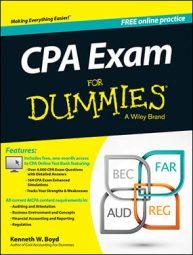The auditing and attestation (AUD) section of the CPA exam heavily tests your ability to audit inventories. Inventory is often one of the largest asset balances on the balance sheet, along with accounts receivable. By definition, the inventory balance changes frequently during a month or year. The inventory balance increases when the firm purchases inventory or manufactures more goods, and when inventory items are sold, inventory decreases.
The frequent changes in inventory can make the auditing process more difficult. The CPA is auditing a balance that may be changing every day.
The more assets (receivables, inventory, and fixed assets) a company has, the more financially healthy it is. The principle of conservatism dictates that the CPA should be concerned about overstatement of asset accounts. The CPA doesn’t want an asset posted to the books unless it truly exists and the asset’s cost can be verified.
To gather audit evidence to support the existence of inventory, CPAs often perform a physical count of inventory during an audit. Here’s an overview of how an inventory count works:
Timing: The CPA firm wants to plan an inventory count as close to the balance sheet date of the audit as possible. Ideally, the count is on the balance sheet date. That timing minimizes the number of transactions (and the dollar amount of change) between the balance sheet date and the inventory count.
Control over inventory: When planning for the day of the inventory count, the CPA wants to prevent any inventory from entering or leaving the company’s facility. The auditor works with the client to communicate the date of the inventory count to staff. If the inventory location is a retail store, the store is typically closed for the day. You may sometimes see stores closed for inventory counts at the mall.
Inventory records, tags: The client prepares a detailed list of all of the items in inventory, a description of each item, the number of items, and the cost. The client prints the list for the auditors and company staff that will perform the inventory count. The inventory list is used to generate inventory tags. The client’s staff prints the tags and attaches the tags to each inventory item.
Counting inventory: Each person counting inventory is assigned pages of the detailed inventory list. The counter locates the physical inventory and compares each item’s description, number of units, and cost from the inventory list to the tag on the inventory item. When a counter finds an inventory item, he removes the tag, keeping all tags for the auditors.
Exceptions: If an inventory counter finds differences between the inventory list and the tag on the inventory item, he notes the exception. In some cases, a counter can’t locate the physical inventory item during the count. An inventory counter may also note physical items that aren’t tagged as inventory. That means that the inventory item isn’t included in inventory account balance.
The CPA firm gathers all the data used to perform the inventory count. The counters ensure that all inventory listing pages and all the tags are collected and filed. The auditors also summarize all the exceptions. Here are some typical exceptions and how a CPA would account for them:
Physical inventory item not located: If the physical inventory item isn’t located, the inventory records are overstated. Inventory needs to be credited (reduced). Cost of goods sold (an expense account) is debited. The principle of conservatism states that if assets are overstated, they’re most often expensed.
Physical inventory item located, not on inventory listing: If a physical inventory item isn’t tagged, the inventory records are understated. No entry was made to increase inventory when the item was purchased or produced. Inventory needs to be debited (increased), and accounts payable needs to be increased.
Data on inventory tag is different from inventory listing: In this case, the item description, number of items, or original cost per unit noted on the inventory tag doesn’t match the inventory listing. The counter wrote down the exception on the inventory tag during the count.
The accounting area needs to track down the purchase order, shipping receipt, or vendor invoice to determine the correct data for the inventory item. Inventory may be increased or decreased, depending on what the original records indicate.
Obsolete inventory: Obsolete inventory no longer has any sales value to the company. The item may be obsolete because it has no more useful life. Perishable items (fruit and vegetables) at the grocery store are good examples.
Technology changes may make a product obsolete. Traditional cameras, for example, are gradually losing market share to digital cameras and camera phones. Following the principle of conservatism, you’d address the overstatement by making an entry to reduce inventory and debiting cost of goods sold.
The auditor’s goal is to verify that the balance of inventory matches the dollar amount of inventory counted, and the auditor’s job is to propose accounting changes for the exceptions. Posting adjusting entries is company management’s job.

